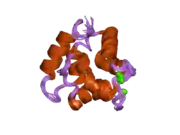| OCM2 | |||||||||||||||||||||||||||||||||||||||||||||||||||
|---|---|---|---|---|---|---|---|---|---|---|---|---|---|---|---|---|---|---|---|---|---|---|---|---|---|---|---|---|---|---|---|---|---|---|---|---|---|---|---|---|---|---|---|---|---|---|---|---|---|---|---|
 | |||||||||||||||||||||||||||||||||||||||||||||||||||
| Identifiers | |||||||||||||||||||||||||||||||||||||||||||||||||||
| Aliases | OCM2, OCM, LOC4951, oncomodulin 2, OM | ||||||||||||||||||||||||||||||||||||||||||||||||||
| External IDs | HomoloGene: 130549 GeneCards: OCM2 | ||||||||||||||||||||||||||||||||||||||||||||||||||
| |||||||||||||||||||||||||||||||||||||||||||||||||||
| |||||||||||||||||||||||||||||||||||||||||||||||||||
| |||||||||||||||||||||||||||||||||||||||||||||||||||
| |||||||||||||||||||||||||||||||||||||||||||||||||||
| Wikidata | |||||||||||||||||||||||||||||||||||||||||||||||||||
| |||||||||||||||||||||||||||||||||||||||||||||||||||
Oncomodulin 2, also known as OCM2, is a human gene that is similar to oncomodulin.[3]
Oncomodulin is a high-affinity calcium ion-binding protein. It belongs to the superfamily of calmodulin proteins, also known as the EF-hand proteins. Oncomodulin 2 is an oncodevelopmental protein found in early embryonic cells in the placenta and also in tumors.[3]
References
- 1 2 3 GRCh38: Ensembl release 89: ENSG00000135175 - Ensembl, May 2017
- ↑ "Human PubMed Reference:". National Center for Biotechnology Information, U.S. National Library of Medicine.
- 1 2 "Entrez Gene: OCM oncomodulin".
Further reading
- Pauls TL, Cox JA, Berchtold MW (1996). "The Ca2+(-)binding proteins parvalbumin and oncomodulin and their genes: new structural and functional findings". Biochim. Biophys. Acta. 1306 (1): 39–54. doi:10.1016/0167-4781(95)00221-9. PMID 8611623.
- Belkacemi L, Simoneau L, Lafond J (2003). "Calcium-binding proteins: distribution and implication in mammalian placenta". Endocrine. 19 (1): 57–64. doi:10.1385/ENDO:19:1:57. PMID 12583602. S2CID 28802052.
- Ritzler JM, Sawhney R, Geurts van Kessel AH, et al. (1992). "The genes for the highly homologous Ca(2+)-binding proteins oncomodulin and parvalbumin are not linked in the human genome". Genomics. 12 (3): 567–72. doi:10.1016/0888-7543(92)90449-3. PMID 1559707.
- Palmer EJ, MacManus JP, Mutus B (1990). "Inhibition of glutathione reductase by oncomodulin". Arch. Biochem. Biophys. 277 (1): 149–54. doi:10.1016/0003-9861(90)90563-E. PMID 2306116.
- Mutus B, Palmer EJ, MacManus JP (1988). "Disulfide-linked dimer of oncomodulin: comparison to calmodulin". Biochemistry. 27 (15): 5615–22. doi:10.1021/bi00415a033. PMID 3179268.
- Gillen MF, Banville D, Rutledge RG, et al. (1987). "A complete complementary DNA for the oncodevelopmental calcium-binding protein, oncomodulin". J. Biol. Chem. 262 (11): 5308–12. doi:10.1016/S0021-9258(18)61189-5. PMID 3558395.
- MacManus JP, Brewer LM, Whitfield JF (1985). "The widely-distributed tumour protein, oncomodulin, is a normal constituent of human and rodent placentas". Cancer Lett. 27 (2): 145–51. doi:10.1016/0304-3835(85)90103-X. PMID 4005827.
- Blum JK, Berchtold MW (1994). "Calmodulin-like effect of oncomodulin on cell proliferation". J. Cell. Physiol. 160 (3): 455–62. doi:10.1002/jcp.1041600308. PMID 8077283. S2CID 25079233.
- Föhr UG, Weber BR, Müntener M, et al. (1993). "Human alpha and beta parvalbumins. Structure and tissue-specific expression". Eur. J. Biochem. 215 (3): 719–27. doi:10.1111/j.1432-1033.1993.tb18084.x. PMID 8354278.
- Sakaguchi N, Henzl MT, Thalmann I, et al. (2000). "Oncomodulin is expressed exclusively by outer hair cells in the organ of Corti". J. Histochem. Cytochem. 46 (1): 29–40. doi:10.1177/002215549804600105. PMID 9405492.
- Sanger Centre, The; Washington University Genome Sequencing Cente, The (1999). "Toward a complete human genome sequence". Genome Res. 8 (11): 1097–108. doi:10.1101/gr.8.11.1097. PMID 9847074.
- Harrington JJ, Sherf B, Rundlett S, et al. (2001). "Creation of genome-wide protein expression libraries using random activation of gene expression". Nat. Biotechnol. 19 (5): 440–5. doi:10.1038/88107. PMID 11329013. S2CID 25064683.
- Strausberg RL, Feingold EA, Grouse LH, et al. (2003). "Generation and initial analysis of more than 15,000 full-length human and mouse cDNA sequences". Proc. Natl. Acad. Sci. U.S.A. 99 (26): 16899–903. Bibcode:2002PNAS...9916899M. doi:10.1073/pnas.242603899. PMC 139241. PMID 12477932.
- Hillier LW, Fulton RS, Fulton LA, et al. (2003). "The DNA sequence of human chromosome 7". Nature. 424 (6945): 157–64. Bibcode:2003Natur.424..157H. doi:10.1038/nature01782. PMID 12853948.
- Gerhard DS, Wagner L, Feingold EA, et al. (2004). "The Status, Quality, and Expansion of the NIH Full-Length cDNA Project: The Mammalian Gene Collection (MGC)". Genome Res. 14 (10B): 2121–7. doi:10.1101/gr.2596504. PMC 528928. PMID 15489334.
- Babini E, Bertini I, Capozzi F, et al. (2005). "Solution structure of human beta-parvalbumin and structural comparison with its paralog alpha-parvalbumin and with their rat orthologs". Biochemistry. 43 (51): 16076–85. doi:10.1021/bi048388o. PMID 15610002.
This article is issued from Wikipedia. The text is licensed under Creative Commons - Attribution - Sharealike. Additional terms may apply for the media files.




